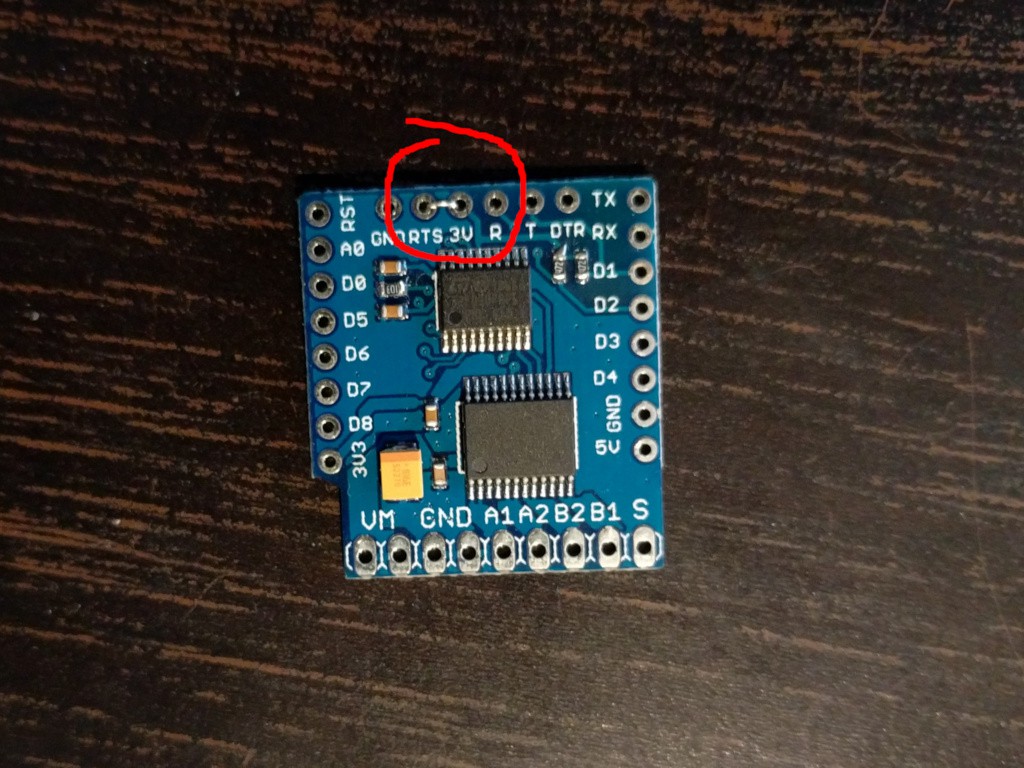Turns out that the procedure in the previous log can be greatly simplified. You don't need an ST-Link programmer, and you don't need to solder anything. Even if your shield is locked, you can unlock and program it with a simple serial adapter. Here is how.
First, clone the repository:
$ git clone https://github.com/pbugalski/wemos_motor_shield $ cd wemos_motor_shield
Make sure you have arm-none-eabi-gcc installed, and compile it:
$ make arm-none-eabi-gcc -Wall -g -std=c99 -Os -mlittle-endian -mcpu=cortex-m0 -march=armv6-m -mthumb -ffunction-sections -fdata-sections -Wl,--gc-sections -Wl,-Map=motor_shield.map -Iinc src/startup_stm32.s src/main.c src/user_i2c.c src/tb6612.c -o motor_shield.elf -Tstm32f030.ld arm-none-eabi-objcopy -O binary motor_shield.elf motor_shield.bin arm-none-eabi-size motor_shield.elf text data bss dec hex filename 2032 1084 1056 4172 104c motor_shield.elf
Now, make sure you have stm32flash utility installed. Short the RTS and the 3V pins on the shield together, like this:

GND ↔ GND
3V3 ↔ 3V3 (or VCC or whatever it is called on your USB2TTL)
D2 ↔ TX
D1 ↔ RX
and connect it to your computer. Now, see if you can communicate with the device:
$ stm32flash /dev/ttyUSB0 stm32flash 0.5 http://stm32flash.sourceforge.net/ Interface serial_posix: 57600 8E1 Version : 0x31 Option 1 : 0x00 Option 2 : 0x00 Device ID : 0x0444 (STM32F03xx4/6) - RAM : 4KiB (2048b reserved by bootloader) - Flash : 32KiB (size first sector: 4x1024) - Option RAM : 16b - System RAM : 3KiB
Now, you can unlock your shield:
$ stm32flash /dev/ttyUSB0 -k stm32flash 0.5 http://stm32flash.sourceforge.net/ Interface serial_posix: 57600 8E1 Version : 0x31 Option 1 : 0x00 Option 2 : 0x00 Device ID : 0x0444 (STM32F03xx4/6) - RAM : 4KiB (2048b reserved by bootloader) - Flash : 32KiB (size first sector: 4x1024) - Option RAM : 16b - System RAM : 3KiB Read-UnProtecting flash Done. $ stm32flash /dev/ttyUSB0 -u stm32flash 0.5 http://stm32flash.sourceforge.net/ Interface serial_posix: 57600 8E1 Version : 0x31 Option 1 : 0x00 Option 2 : 0x00 Device ID : 0x0444 (STM32F03xx4/6) - RAM : 4KiB (2048b reserved by bootloader) - Flash : 32KiB (size first sector: 4x1024) - Option RAM : 16b - System RAM : 3KiB Write-unprotecting flash Done.And now you can flash it:
$ stm32flash /dev/ttyUSB0 -v -w motor_shield.bin stm32flash 0.5 http://stm32flash.sourceforge.net/ Using Parser : Raw BINARY Interface serial_posix: 57600 8E1 Version : 0x31 Option 1 : 0x00 Option 2 : 0x00 Device ID : 0x0444 (STM32F03xx4/6) - RAM : 4KiB (2048b reserved by bootloader) - Flash : 32KiB (size first sector: 4x1024) - Option RAM : 16b - System RAM : 3KiB Write to memory Erasing memory Wrote and verified address 0x08000c2c (100.00%) Done.
Then disconnect all the wires (including the RTS pin), connect the shield to your WeMos D1 Mini, and it should work.
 deʃhipu
deʃhipu
Discussions
Become a Hackaday.io Member
Create an account to leave a comment. Already have an account? Log In.
Hi all, thx for the fix. I would like to use ESPeasy with the D1 mini and motorshield. But currently there is no plugin available, only for the adafruit motor shield. Is anybody able to support me in writing a plugin for ESPeasy?
https://www.letscontrolit.com/forum/viewtopic.php?f=6&t=2844&p=28237#p28237
Are you sure? yes | no
Hi folks,
I'm struggling to communicate with my motor shield.
Using this Arduino USB2TTl device..
https://www.jaycar.com.au/arduino-compatible-usb-to-serial-adaptor-module/p/XC4464
Which, while it has a switch for 5v /3.3v data power, seems to lack a 3.3 v power output. I have stm32flash working on a Raspberry Pi and it flickers the LEDs on the USB2TTL device but fails to initialize the motor shield.
I tried powering the 3.3 v input on the motor shield from a separate serial adaptor that had such an output but I have a feeling I'm not connecting to the right bits. Not sure how to post an image here but here's a link to an image with my assumptions and question marked up on the same image as the OP posted at the start of this thread
http://motioncircus.com/WemosMotorConnectionsEdited.jpg
Any suggestions welcome
Thanks for your generous sharing
Sdack
Are you sure? yes | no
Hey, I hope it's not too late to ask some questions about this! I'm trying my hardest to get this working since I have a project where I'm only driving a stepper motor twice a week and I immediately saw the shield getting stuck in standby after more than ten seconds idle.
I have access to windows and linux (through a Pi) but am having a hell of a time getting a FT232RL adapter to work for programming it. On windows with the STM32 flashing program I can't get it to recognize the board. Via Arduino IDE I'm having even less luck. I'm attempting to follow your guide for linux but having trouble downloading the arm-none-eabi-gcc. Could you please offer some help? My email is brockmeier.adam@gmail.com. I appreciate the help in advance! -Adam
Are you sure? yes | no
Hi, you don't need arm-none-eabi-gcc if you use the precompiled images that are available for download in the "files" section of this project.
Are you sure? yes | no
Oh, that makes it easier. So I did try shorting 3v and RTS and attempting to connect through stm32 flash utility (matching baud rate that you had in the example and making sure it was set the same through device manager) but it would only time out. Any guesses on the issue? D1 and D2 are the pins along the side of the board not the top, correct?
Are you sure? yes | no
Correct. Make sure you also have GND and power connected. If it still doesn't work, double-check your connections, check there isn't anything else using that serial port, etc. — it should work.
Are you sure? yes | no
I got it! The secret must have been a good night's sleep. Thanks for the help!
Are you sure? yes | no
Brilliant, I used a Pro Mini USB to serial converter I had lying around, fastest fix ever!
Are you sure? yes | no